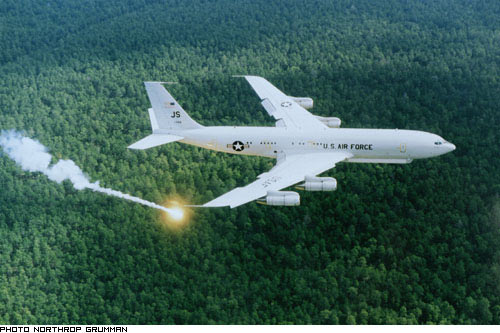Boeing/Northrop Grumman E-8 Joint STARS
Summary
| Category | Other aircraft |
| Origin country | 🇺🇸 United States |
| First flight | 1 January 1994 |
| Year of introduction | 1996 |
| Number produced | 17 units |
| Average unit price | $250 million |
Description
Joint STARS evolved from separate U.S. Army and Air Force (USAF) programs initiated to develop technology capable of detecting, locating, and engaging enemy armor beyond the forward line of a battle. In 1982, these programs were merged, with the USAF taking the lead role. The concept and sensor technology underpinning the E-8 were initially developed and tested on the Tacit Blue experimental aircraft. Grumman Aerospace Corporation was awarded the prime contract in September 1985 to produce two E-8A development systems. In 2005, Northrop Grumman received a contract to upgrade the engines and other systems. Pratt & Whitney, in a joint venture with Seven Q Seven (SQS), were contracted to produce JT8D-219 engines for the E-8s. In December 2008, an E-8C test aircraft completed its first flight with the new engines, and in 2009, the company commenced engine replacement and further upgrades.
The E-8C is an aircraft modified from the Boeing 707-300 series commercial airliner, designed to carry specialized radar, communications, operations, and control subsystems. The aircraft’s interior is dedicated to housing these systems along with 18 operator workstations to manage and disseminate battlefield information. Externally, the most prominent feature is the 40 ft (12 m) canoe-shaped radome, located under the forward fuselage, which houses the 24 ft (7.3 m) APY-7 active electronically scanned array side-looking airborne radar antenna.
The AN/APY-7 radar is optimized for tracking ground vehicles and some aircraft, collecting imagery, and relaying tactical pictures. This jam-resistant system allows the E-8C to operate effectively even under heavy electronic countermeasures and can fly a mission profile for nine hours without refueling. The AN/APY-7 radar can operate in various modes, including wide area surveillance, ground moving target indicator (GMTI), fixed target indicator (FTI), target classification, and synthetic aperture radar (SAR), providing comprehensive battlefield information. Range and on-station time are further extendable through in-flight refueling.
The Northrop Grumman E-8 Joint STARS was not designed to carry offensive or defensive weaponry. Its primary function is surveillance, reconnaissance, and battle management. While not equipped with conventional munitions, the E-8C's capabilities provide targeting data and intelligence crucial for attack aviation, naval surface fire, field artillery, and friendly maneuver forces, effectively enhancing the firepower of other assets.
The two E-8A development aircraft saw early deployment in 1991 during Operation Desert Storm; they tracked Iraqi mobile forces, accumulating over 500 combat hours across 49 sorties with a 100% mission effectiveness rate. Subsequently, these developmental aircraft participated in Operation Joint Endeavor in December 1995, monitoring ground movements in support of the Dayton Peace Accords. The first production E-8C was delivered in June 1996 and deployed in support of Operation Joint Endeavor that October. From February to June 1999, Joint STARS supported Operation Allied Force, accumulating over 1,000 flight hours with a 94.5% mission-effectiveness rate during the Kosovo War. From 2001 to January 2011, the Joint STARS fleet flew more than 63,000 hours in 5,200 combat missions in support of Operations Iraqi Freedom, Enduring Freedom, and New Dawn. JSTARS ended its continuous presence in the United States Central Command (USCENTCOM) areas of responsibility on 1 October 2019, after an 18-year deployment encompassing 10,938 sorties and 114,426.6 combat hours. From late 2021 to early 2022, E-8C JSTARS aircraft were deployed to Europe, monitoring military activity in Eastern Europe, including over Ukrainian airspace until late February 2022.
Main Variants:
-
E-8A: The original platform configuration served as the initial test and development version of the Joint STARS program.
-
TE-8A: This variant had its mission equipment removed and was repurposed for flight crew training.
-
YE-8B: A single aircraft, originally intended to be a U.S. Navy Boeing E-6 Mercury, was transferred to the U.S. Air Force for development purposes.
-
E-8C: This is the production configuration of the Joint STARS platform, converted from Boeing 707s for airborne ground surveillance, battle management, and command and control roles.
Technical specifications
| Version: E-8 Joint STARS | |
|---|---|
| Crew | 24 to 40 |
| Maximum speed | 853 km/h (530 mph) |
| Wing area | 283.4 m² (3050.0 sqft) |
| Wingspan | 44.4 m (145.7 ft) |
| Height | 13.0 m (42.5 ft) |
| Length | 46.6 m (152.9 ft) |
| Service ceiling | 12802 m (42001 ft) |
| Empty weight | 77564 kg (170999 lbs) |
| Max. takeoff weight | 152407 kg (336000 lbs) |
| Powerplant | 4 × turbojets Pratt & Whitney TF33-102C delivering 8709 kgp |
Current operating countries
| Country | Units | ||
|---|---|---|---|
|
|
United States | 14 | |
Numbers in parentheses, e.g. '(+5)', indicate units ordered but not yet delivered.
All operators
Photo of E-8 Joint STARS
